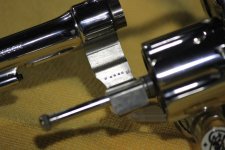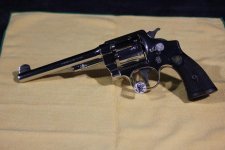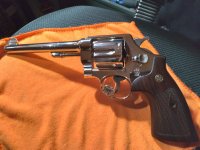Lack of cartridge markings on hand ejectors is relatively rare. The first case was the first Model HE, the model 1896 32 Long; one model, one cartridge.
The 455 BSR is more well known, still roughly only as high as maybe 10%. But it was for one customer the English military, with a single purpose, WW I. The users were only given ammo that fit the gun, 455 MkI and II. Although primarily intended for the newer and shorter Mk II, the chambers are actually cut longer to also accommodate the older and longer MkI for a wartime supply contingency.
It's only a problem in its 2nd life as a surplus firearm.
Before the S&W hand ejectors, guns that fired only one cartridge were much more prevalent, leading to more guns of yesteryear w/o cartridge markings.
The 455 BSR is more well known, still roughly only as high as maybe 10%. But it was for one customer the English military, with a single purpose, WW I. The users were only given ammo that fit the gun, 455 MkI and II. Although primarily intended for the newer and shorter Mk II, the chambers are actually cut longer to also accommodate the older and longer MkI for a wartime supply contingency.
It's only a problem in its 2nd life as a surplus firearm.
Before the S&W hand ejectors, guns that fired only one cartridge were much more prevalent, leading to more guns of yesteryear w/o cartridge markings.
Last edited:











